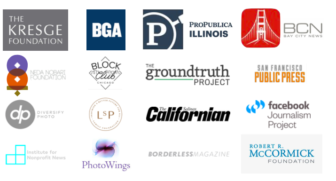During a time where journalism, on the whole, has declined, visual journalism has been hit the hardest. Over the last 10 years, the number of visual journalists has declined by 52%, more than any other newsroom staff members.
Without visual journalism, there’s no representation of the communities local newsrooms cover. It’s harder to make an emotional connection that ties a reader to the triumphs and turmoils of someone else’s life.
Now, picture this: A media landscape with consistently powerful visual journalism that represents all communities respectfully. That’s what INN member CatchLight is envisioning with its program, CatchLight Local.
“Images are shared language,” said CatchLight CEO Elodie Mailliet Storm during INN’s Dec. 3 webinar, CatchLight Local: New Model for Sustainable Visual Journalism with CatchLight and INN. “Yet media organizations in recent years have not invested in visuals.”
CatchLight Local is not just about newsrooms’ accessibility to high-quality, thoughtful images, though that’s part of the idea. It’s about creating sustainable visual programs and engaging local communities in creating those visuals.
With two pilot projects underway, in the Bay Area and Chicago, the program is now sharing what it has learned — and exploring opportunities to branch out to other locations.
Housing Inequity
The CatchLight Local program started 18 months ago in the Bay Area of California with a pilot focused on long-form storytelling.
Sebastián Hidalgo was one of the inaugural CatchLight Local fellows, working to cover the farming community of Salinas, California. The setting of John Steinbeck’s novel “East of Eden,” Salinas is home to more than 155,000 people — with about 17% living in poverty.
For Hidalgo, creating visual journalism to represent the struggle of finding housing in the community not far from Silicon Valley meant hosting listening events, sharing surveys and being as accessible as possible. It meant centering the community in the project.

The result: Spending time at laundromats, where residents find housing through ads on the bulletin boards, posted one day and gone the next. After forming relationships with folks who frequented the laundromats, Hidalgo was able to visually capture the fierce housing market. Working with Gannett’s Salinas Californian, he and his colleagues created a Know Your Rights as a Tenant document for undocumented farmworkers. They published tips on how to negotiate with landlords, in both Spanish and English.
The effort was about showing up for folks with information needs that are often unmet and building trust with new communities.
Racial Disparities
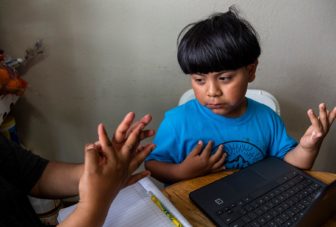
David Rodriguez / CatchLight Local
Photo by David Rodriguez
Another CatchLight fellow, David Rodriguez, also worked at the Salinas Californian after Hidalgo, covering racial disparities in Latin communities in Monterey County during the pandemic. He focused on hunger, as the outbreak threatened jobs.
His projects resulted in donations of cash and food that directly aided the community he covered.
“What visuals and text can do when paired together — it has the power to bring people together and help those in need,” said Rodriguez.
For CatchLight newsroom partner Sheyanne Romero, editor-in-chief at the Salinas Californian, working with CatchLight has been invaluable. Since Rodriguez’s series, the paper has had more community interaction and recognition, resulting in new subscriptions and a higher level of loyalty.
“David, he’s a fabulous photographer. What I’ve seen over the past couple of months, we could have never done ourselves,” Romero said. “There’s not a price tag you can put on (the work and his growth).”
Chicago
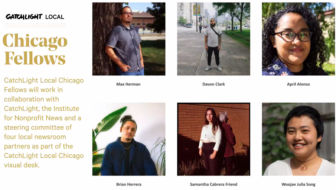
With lessons learned from the Bay Area, CatchLight has moved into Chicago, in partnership with INN. This time, CatchLight has created a shared photo desk for the community, with four INN member outlets participating: Better Government Association, Block Club Chicago, Borderless Magazine and ProPublica Illinois. The program was designed in collaboration with INN to provide high-quality, local photojournalism in places where wire photography may not be suitable or sufficient.
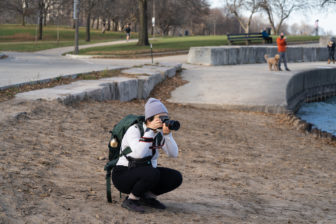
CatchLight fellow Julia Song works on a COVID-19-related assignment for Block Club Chicago on November 12, 2020. (Photo: Max Herman)
Each fellow is producing short-form assignments and a deep-dive story with the participating newsrooms over six months.
Max Herman, assignment editor fellow for the Chicago project, said CatchLight offers a new way of thinking about storytelling.
“Visuals, whether it’s photos or illustrations, are thought of at the last minute as the story’s complete,” he said. “In this fellowship, we’re trying to get (fellows) embedded in the storytelling earlier on with true collaborations with the editors and reporters.”

Chicago CatchLight Local fellow April Alonso delivers flyers in preparation for her deep dive collaborative project with Borderless Magazine on November 17, 2020. (Photo: Michelle Kanaar)
The visual fellows come in early in the process. The newsrooms benefit from a pool of shared imagery, similar to high-quality stock images, they can use in stories for and about Chicago residents.
The shared desk offers a shared investment in visual editors, community engagement, analytics training and more. — that means they have to make less of an investment on their own to get these essential services.
How can other INN members, funders, supporters and stakeholders get involved?
CatchLight Local is in discussion to expand with news organizations in Colorado, Texas and Canada.
But this program is designed to scale.
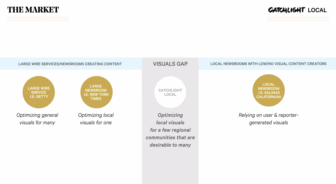
CatchLight Local has worked for the past 18 months with partners including INN, the Robert R. McCormick Foundation, the Kresge Foundation, The Ground Truth Project, Google, Lenfest Institute and seven local for-profit and nonprofit newsrooms on a new model for inclusive visual journalism.
At INN, we’re more than happy to help facilitate the growth of accessible, powerful, respectful visual journalism to interested communities.
“Part of INN’s role is to take projects in one area and learn how to expand them into other areas,” said INN Chief Network Officer Jonathan Kealing. “We’re committed to taking those learnings and lessons and taking them to other communities.”
If you’d like to learn more about CatchLight Local or potential expansion opportunities, please reach out to Catchlight CEO Elodie Mailliet Storm or INN Chief Network Officer Jonathan Kealing.
Thank you to these partners for their support for the CatchLight Local program:
